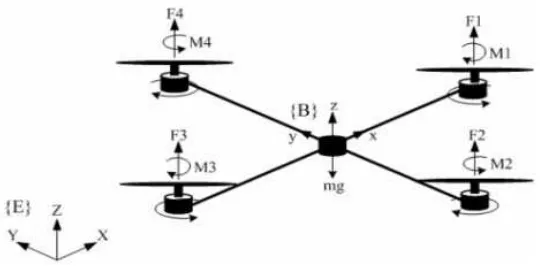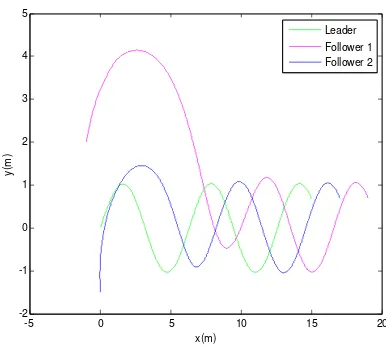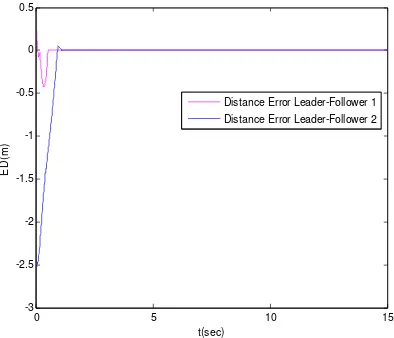DOI: 10.12928/TELKOMNIKA.v13i1.994 85
Improved Leader Follower Formation Control for
Multiple Quadrotors Based AFSA
Rabah Abbas*, Qinghe Wu
School of Automation, Beijing Institute of Technology, Beijing 100081, Beijing, China *Corresponding author, e-mail: [email protected]
Abstract
In this paper, formation tracking in plane with equal height for all quadrotors is discussed. Two controllers are necessary. First, PID controller is used to ensure the tracking of the desired trajectory by the first quadrotor named leader. The formation of the quadrotors in plane is achieved by using the directed lyapunov controller. In order to improve the controller performances, the artificial fish swarm algorithm is used to ensure the dynamic optimization of the parameter controllers. When the desired shape formation is achieved, PID controller is used again to ensure the keeping of this formation shape. Finally, simulation results demonstrate the effectiveness of the proposed controllers compared to the ordinary controller and also compared to the static optimization by using the same algorithm.
Keywords: AFSA (artificial fish swarm algorithm), PID, formation, quadrotor
1. Introduction
Quadrotors have become the interest of many researches in the word [1]-[4]. Quadrotor can also perform solo mission where it can achieve good performances. This characteristic will become more interesting when it operate in a coordinated fashion such as formation and trajectory tracking.
In last decade, tracking formation control for multiple uavs has become the interest of many researches in the word. Based on separated saturations and a multi-agent consensus algorithm is developed to ensure the tracking formation control of mini quadrotor [5]. In [6], 3D path-following of multiple quadrotors based lyapunov approach was considered. Integral backstepping controller is used to maintain a desired formation tracking control for multiple uavs is presented in [7]. In [8] the authors investigate tracking controls for an arbitrary number of cooperating quadrotor unmanned aerial vehicles with a suspended load. In [9] Two controllers based on PID and sliding mode were used to ensure the tracking formation for quadrotors uavs. In [10], the synchronized position tracking controller is incorporated in formation flight control for multiple uavs. In [11] based on linear PD and sliding mode controller, flight formation control for leader follower quadrotor is presented, It is tested in real application.
Motivated by the different advantages of the quadrotor, the present paper studies the problem of leader follower formation control for multiple quadrotors. The present work is mainly based on [11], the control strategy is divided on two parts such as the tracking and formation tracking control. In the first part, PID controller is used to ensure the tracking of the desired trajectory by the first quadrotor named leader. This controller is also used to ensure the keeping formation by the followers. The second part is devoted for the formation tracking in plane with equal height ( ) for all quadrotors.
2. Quadrotor Dynamic Model
The motion of quadrotor is controlled by varying the rotation speed of the four rotors to change the thrust and the torque produced by each one (Figure 1).
Figure 1. Quadrotor Configuration
In this paper, we consider the model dynamic based Newton-Euler approach. The dynamic model is presented as [16],[17]:
(1)
, , Correspond to the relative position of the mass centre of the quadrotor with respect to an inertial coordinate frame, is the gravitational acceleration. is the length from the mass centre to the rotor, , , denotes the three Euler angles that represent the attitude of the quadrotor, namely roll-pitch-yaw of the quadrotor. is the thrust force vector in the body system. , and correspond to the control inputs of roll, pitch and yaw moments, respectively.
3. Controller Design
In this section, two controllers are designed to ensure the tracking and the formation for multiple quadrotors.
3.1. Tracking controller
A simple PID is designed to ensure the tracking of the desired trajectory by the first quadrotor named leader. It is also used to ensure the keeping of formation in x-y plane. The controller can be expressed as:
(2)
With and are the error and the derivation of error in i- direction. The error is defined as:
3.2.Formation Controller Design
The formation control by keeping a fixed distance and a fixed deviation ∆ between the leader and the i-th follower quadrotors (Figure 2).
Now, we consider quadrotors. In our study we assumed that the quadrotors has the same translational dynamic model in plane as given by the following system [11]:
Figure 2. Position and orientation of the leader and follower quadrotors in plane [11]
cos sin
sin cos
(4)
Where: and are the velocity component in the and directions. is the angular velocity for the yaw angle and , for the leader and the follower quadrotors.
3.3. Distance and angle controller
Let , be the x and y coordinates of the vector drawn from the mass center of the leader to the one of the follower, in the leader’s body fixed frame. These two coordinates can be given by:
cos sin
sin cos (5)
We consider the orientation and the formation errors defined as:
(6)
After some simplifications, we obtain [11]:
In matrix form, (05) can be written as:
(8)
With , ,
cos sin
sin cos and
We choose the lyapunov candidate function as:
(9)
Differentiating with respect to time and considering Equation (09) we have:
X X (10)
To satisfy the Lyapunov stability condition, it is obvious to choose as follows:
(11)
Where is a diagonal positive matrix. , , . Then < 0 is negative definite.
3.4. Optimization
In order to improve the controller proposed in (11), AFSA is applied to tune the controller parameters ( , , ) for better time convergence of the formation control errors. For this we defined (fitness function) as convergence criterion to evaluate the cost of the proposed algorithm. In this context the fitness function of the artificial fishes is defined as follows:
∆ (12)
with: And ∆ are the distance and the orientation error
between the leader and follower. The best fitness is the smallest fitness value among the artificial fishes which correspond to the best values of , .
3.4.1. Artificial Fish swarm Algorithm
The artificial fish individual state can be expressed as n dimension vector. , … . Each artificial fish represents a solution to the optimization problem. In our case this solution given by AF represents a set of controller parameters which can make the
function minimal. This algorithm can be presented as follow:
. .
(13)
The behavior of swarm: We assume as the number of the neighbors within the visual
distance of the AF. The swarming of AF from to will be taken place if the corresponding concentration food ( ) at state c is more important than the food concentration ( ) at state and the swarm is not crowd ( ). Otherwise AF chooses to search food behavior. This step can be summarized by:
| | . .
(14)
The behavior of follow: In this behavior, The AF swarm from his actual state to the largest food concentration if the concentration of food (y >y) is more important and the swarm is not crowd. Otherwise AF chooses to search food behavior. This step can be summarized by:
| | . .
(15) Finally, the best fitness and the best fish correspond to this best function are selected.
3.4.2.Static Optimization
In this technique, for N iterations of algorithm one best fitness function is chosen. This function corresponds to the best controller parameters. These parameters will be injected in the controller (11).
3.4.3.Dynamic Optimization
In this technique and different to the static technique, for each iteration of algorithm a best function is selected and a best controller parameters correspond to this function are also selected and online injected in the controller (11). The same procedure will be repeated until the n-th iteration.
4. Results and Analysis
The proposed formation control has been simulated for the case of three quadrotors (one leader and two followers). The controllers’ objectives are: First: The tracking of trajectory
by the quadrotor leader described by: , sin , . Second: The
formation and the keeping of formation by the followers described by the desired distance and deviation angle to the leader are given by:
First follower meters and ∆ and for the second follower meters
Figure 3. Trajectories of leader and follower quadrotors in direction before optimization
Figure 4. Trajectories of leader and follower
quadrotors in plane before optimization
Figure 5. Distance error between leader and follower quadrotors before optimization
Figure 8. Distance error between leader and follower quadrotors by using static optimization
Figure 11. Distance error between leader and follower quadrotors by using dynamic optimization
Figure 9. Angle error between leader and follower quadrotors by using static optimization
Figure 12. Angle error between leader and follower quadrotors by using dynamic optimization
Figure 3 depicts the trajectories of the position for the leader and also the follower quadrotors. The trajectories of the leader and follower quadrotors in plane (Desired formation) are depicted in Figure 4, while the distance and angle errors between leader and follower quadrotors by using the controller (11) are depicted in Figure 5 and Figure 6, respectively.
By using static optimization as shown in Figures 7, 8 and 9, the results are improved comparatively to the Figures 4, 5 and 6. From Figures 10, 11 and 12, It is shown the results are considered perfect in term of error convergence (both distance and error between leader and follower quadrotors), this can be explain by the fact that in dynamic optimization case, the parameters are selected dynamically which ensure that the distance and angle errors are minimal for each iterration of the proposed algorithm. Compared to the static optimization case, only one fitness function is selected, this function is not necessary correspond to the good parameters for the iteration of the algorithm.
a direct lyapunov method a new controller is proposed to ensure the formation tracking in plane with equal height ( ) for all quadrotors, and then PID is used again to ensure the keeping of formation by the followers.
Simulation results demonstrate that the proposed AFSA algorithm is an effective tuning strategy of Lyapunov-based controller’s parameter controls. AFSA algorithm leads to satisfying and efficient formation tracking performances in terms of the speed of convergence of the tracking errors and time achieving of the desired formation by tuning the controller parameters dynamically.
References
[1] A Tayebi, S McGilvray. Attitude stabilization of a vtol quadrotor aircraft. IEEE Transactions on Control Systems Technology. 2006; 14(3): 562-571.
[2] T Madani, A Benallegue. Control of a quadrotor mini-helicopter via full state backstepping
technique. 45th IEEE Conference on Decision and Control. San Diego, CA. 2006; 1515-1520. [3] L Derafa, A Benallegue, L Fridman. Super twisting control algorithm for the attitude tracking of a four
rotors UAV. Journal of the Franklin Institute. 2012; 349(2): 685-699.
[4] K Hicham. Robust control algorithm considering the actuator faults for attitude tracking of an UAV Quadrotor Aircraft. International Journal of Control and Automation. 2012; 5(4): 55-66.
[5] Jose AG, Pedro CSS, Rogelio L. Mini rotorcraft flight formation control using bounded inputs. J Intell Robot Syst. 2012; 65(1-4): 175–186.
[6] Venanzio C, Isaac K, Enric X, Vladimir D, Naira H, A Pedro A, Antonio MP. A Lyapunov-based
approach for Time-coordinated 3D path-following of multiple Quadrotors. 51st IEEE Conference on Decision and Control. USA. 2012: 1776-1781.
[7] Lon D, Nadav B, Shai A. Formation flight using multiple integral backstepping controllers. IEEE. 5th
International Conference on Cybernetics and Intelligent Systems (CIS). China. 2011: 317-322.
[8] Taeyoung L, Koushil S, Vijay K. Geometric control of cooperating multiple quadrotor UAVs with a
suspended payload. 52nd IEEE Conference on Decision and Control. Italy. 2013: 5510-5515. [9] Mohammad F Bin Abas, Dwi P, Syaril A, Md. Ali, D KeIwakura, Yuze S, Kenzo N, Daigo F. Circular
leader-follower formation control of quad-rotor aerial vehicles. Autonomous Control Systems and
Vehicles Intelligent Systems, Control and Automation: Science and Engineering. 2013; 65: 109-132.
[10] Norman HML, Hugh HTL. Formation UAV flight control using virtual structure and motion
synchronization. American Control Conference. USA. 2008: 1782-1787.
[11] DA Mercado, R Castro, R Lozano. Quadrotors flight formation control using leader-follower approach.
European control conference. Zurich. 2013: 3858-3863.
[12] Li XL, Shao Z, Qian J. An optimizing method based on autonomous animals: fish swarm algorithm.
Systems Engineering Theory and Practice. 2002; 22(11): 32-38.
[13] F Yacef, O Bouhali, M Hamerlain, A Rezoug. PSO optimization of Integral backstepping controller for
quadrotor attitude stabilization. Proceedings of the 3rd International Conference on Systems and Control, Algeria. 2013: 462-466.
[14] Karim B, Zhu Q.Genetic fuzzy logic control technique for a Mobile Robot tracking a moving target.
IJCSI International Journal of Computer Science Issues. 2013; 10(1): 607-613.
[15] Wael MK, Hassen TD, Hassan ME. Bacterial foraging oriented by particle swarm optimization
strategy for PID tuning. 8th IEEE international conference on Computational intelligence in robotics and automation. USA. 2009: 445-450.
[16] Daewon L, H Jin K, Shankar S. Feedback linearization vs adaptive sliding mode control for a
quadrotor Helicopter. International Journal of Control, Automation and Systems. 2009; 7(3): 419-428.
[17] Mingu K, Youdan K, Jaiung J. Adaptive sliding mode control using slack variables for affine

![Figure 2. Position and orientation of the leader and follower quadrotors in �� � �� plane [11]](https://thumb-ap.123doks.com/thumbv2/123dok/246649.503727/3.595.187.408.166.347/figure-position-orientation-leader-follower-quadrotors-plane.webp)

